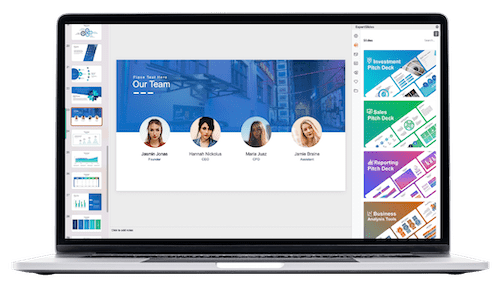Executive Presentation – Tips and Success
Table of Contents
Effective executive presentations are a vital component of business communication, serving as a means to convey key information to various audiences, including team members, clients, and stakeholders. To achieve a successful presentation, it is crucial to understand the target audience, organize the content in a logical and coherent manner, incorporate visual aids to enhance engagement, foster audience participation, manage anxiety and nonverbal cues, navigate question-and-answer sessions, and maintain momentum by following up after the presentation.
Key Takeaways
- Know your audience: Understand their needs, interests, and level of knowledge to tailor your presentation effectively.
- Structure your presentation: Organize your content in a clear and logical manner to keep the audience engaged and focused.
- Use visual aids wisely: Utilize visuals to enhance your message and make it more memorable, but avoid overwhelming the audience with too much information.
- Engage the audience: Encourage interaction, ask questions, and use storytelling to keep the audience interested and involved in your presentation.
- Manage nervousness and body language: Practice relaxation techniques, maintain good posture, and use gestures to convey confidence and credibility.
Understanding the Audience

Know Your Audience’s Level of Knowledge
Consider their level of knowledge on the topic, their interests, and their expectations. This knowledge will help you focus on the most critical aspects of your presentation. For instance, if you are presenting to a group of investors, you may want to focus on financial data and projections. On the other hand, if you are presenting to your team, you may want to emphasize the impact of the information on their day-to-day work.
Consider Cultural Background and Communication Preferences
Understanding your audience’s cultural background and communication preferences is also crucial. If you are presenting to an international audience, you may need to adjust your language and visual aids to ensure they are easily understood. Additionally, some audiences may prefer a more interactive presentation style, while others may prefer a more formal approach.
Tailor Your Presentation for Maximum Impact
By understanding your audience’s preferences, you can tailor your presentation to meet their needs, ensuring your message is well-received. This understanding will help you create a presentation that resonates with your audience and keeps them engaged throughout.
Structuring Your Presentation
The structure of your executive presentation is crucial to its success. A well-structured presentation will help you deliver your message in a clear and organized manner. Start by outlining the key points you want to cover and organizing them in a logical sequence.
This will help you stay focused and ensure that your audience can easily follow your train of thought. When structuring your presentation, it is important to consider the introduction, body, and conclusion. The introduction should grab the audience’s attention and provide an overview of what will be covered.
The body of the presentation should delve into the key points in detail, using examples and evidence to support your message. Finally, the conclusion should summarize the main points and leave the audience with a clear takeaway. In addition to the overall structure, it is important to consider the flow of your presentation.
Transition smoothly between topics and use signposts to guide your audience through the presentation. This will help them stay engaged and follow your message more easily. By structuring your presentation effectively, you can ensure that your audience stays focused and retains the key information you are presenting.
Using Visual Aids Effectively
| Metrics | Success Tips |
|---|---|
| Engagement | Use storytelling to captivate the audience |
| Clarity | Keep slides simple and focused on key points |
| Delivery | Practice and rehearse to ensure a confident delivery |
| Visuals | Use visuals to enhance understanding and retention |
Visual aids can greatly enhance the impact of your executive presentation. They can help clarify complex information, make data more digestible, and keep the audience engaged. When using visual aids, it is important to choose the right type for your message.
For example, if you are presenting data, charts and graphs may be more effective than text-heavy slides. If you are presenting a process or workflow, diagrams or flowcharts may be more appropriate. In addition to choosing the right type of visual aid, it is important to keep them simple and uncluttered.
Avoid using too much text or information on a single slide, as this can overwhelm the audience and detract from your message. Instead, use visuals to complement your spoken words and emphasize key points. When using visual aids, it is also important to practice with them beforehand.
Ensure that they are easy to read from a distance and that they enhance your message rather than distract from it. By using visual aids effectively, you can make your executive presentation more impactful and memorable for your audience.
Engaging the Audience

Engaging your audience is essential for a successful executive presentation. A passive audience is less likely to retain information or be persuaded by your message. To engage your audience, consider using interactive elements such as polls, questions, or group activities.
This will encourage participation and keep the audience actively involved in the presentation. In addition to interactive elements, it is important to use storytelling and real-life examples to make your message more relatable. Personal anecdotes or case studies can help bring your message to life and make it more memorable for the audience.
Additionally, using humor or emotion can help create a connection with the audience and keep them engaged throughout the presentation. Finally, consider using open-ended questions or prompts to encourage discussion and feedback from the audience. This will make them feel more involved in the presentation and give them an opportunity to share their thoughts or ask for clarification on key points.
By engaging your audience, you can create a more dynamic and impactful executive presentation.
Managing Nervousness and Body Language
Nervousness is common when delivering an executive presentation, but it is important to manage it effectively to ensure a confident delivery. Start by practicing your presentation multiple times before the actual event. This will help you become more familiar with the content and reduce anxiety about forgetting key points.
In addition to practice, it is important to pay attention to your body language during the presentation. Stand tall, make eye contact with the audience, and use gestures to emphasize key points. This will help convey confidence and authority, even if you are feeling nervous inside.
Breathing exercises can also help manage nervousness before and during the presentation. Take deep breaths before stepping on stage to calm your nerves, and continue deep breathing if you start feeling anxious during the presentation. By managing nervousness and using confident body language, you can deliver a more impactful executive presentation.
Handling Q&A Sessions
Q&A sessions are an important part of an executive presentation as they give the audience an opportunity to seek clarification or share their thoughts on the topic. When handling Q&A sessions, it is important to listen carefully to each question and respond thoughtfully. If you do not know the answer to a question, it is okay to admit it and offer to follow up with the person after the presentation.
In addition to responding to questions, it is important to manage the time effectively during Q&A sessions. Set clear expectations at the beginning of the session regarding how much time will be allocated for questions and how they should be asked (e.g., raising hands or using a microphone). This will help keep the session organized and ensure that all questions are addressed within the allotted time.
Finally, be open to feedback during Q&A sessions and use it as an opportunity to further engage with the audience. Thank them for their questions and encourage them to reach out if they have further inquiries after the presentation. By handling Q&A sessions effectively, you can create a more interactive and informative executive presentation.
Following Up After the Presentation
Following up after an executive presentation is crucial for maintaining momentum and building on the message delivered during the presentation. Start by sending a thank-you email to all attendees, expressing gratitude for their time and attention during the presentation. This will help reinforce a positive impression of you and your message.
In addition to a thank-you email, consider sharing additional resources or materials related to the presentation topic. This could include whitepapers, case studies, or relevant articles that further support or expand on the information presented during the session. Providing additional resources shows that you are committed to providing value beyond the initial presentation.
Finally, consider scheduling follow-up meetings with key stakeholders or individuals who expressed interest in specific aspects of the presentation. This will give you an opportunity to delve deeper into certain topics or address any lingering questions or concerns they may have. By following up after the presentation, you can continue building relationships with your audience and reinforce the impact of your message.
In conclusion, delivering a successful executive presentation requires careful planning and execution across various aspects such as understanding the audience, structuring the presentation effectively, using visual aids, engaging the audience, managing nervousness and body language, handling Q&A sessions, and following up after the presentation. By paying attention to these key elements, you can create a more impactful and memorable executive presentation that resonates with your audience and achieves its intended goals.
FAQs
What is an executive presentation?
An executive presentation is a formal presentation given to high-level executives within an organization. It typically involves presenting important information, data, or proposals to key decision-makers.
What are some tips for delivering a successful executive presentation?
Some tips for delivering a successful executive presentation include: – Knowing your audience and tailoring the presentation to their interests and needs – Keeping the presentation concise and focused on key points – Using visual aids and data to support your points – Practicing and rehearsing the presentation beforehand – Being confident and engaging during the delivery
What are some common mistakes to avoid in an executive presentation?
Some common mistakes to avoid in an executive presentation include: – Overloading the presentation with too much information – Failing to address the needs and concerns of the audience – Reading directly from slides or notes – Lack of preparation and practice – Failing to engage with the audience
How can one measure the success of an executive presentation?
The success of an executive presentation can be measured by factors such as: – The level of engagement and interest from the audience – The ability to effectively convey key messages and information – The impact of the presentation on decision-making and outcomes – Feedback and reactions from the audience – The achievement of the desired objectives or outcomes outlined in the presentation.
Get 15+ Mio. PowerPoint Assets - FREE SIGN-UP

Sign up for free to our PowerPoint extension, ExpertSlides. Everything you need, directly in PowerPoint. No credit card required.
Main Menu
Knowledge base
Useful Links






